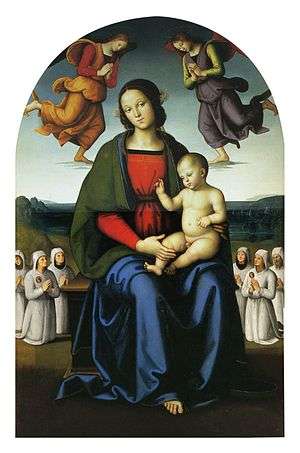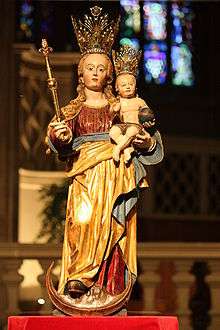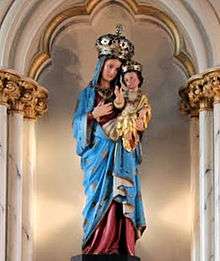Our Lady of Consolation
Starting in the 2nd century, Catholics venerated Mary as Our Lady of Consolation, one of her earliest titles of honor. The title of "Our Lady of Consolation", or "Mary, Consoler of the Afflicted", comes from the Latin Consolatrix Afflictorum.[1] It is found in the Litany of Loreto.

Augustinians
The origin of this invocation is derived from the Augustinian monks who propagated this particular devotion. In 1436 the Confraternity of the Holy Cincture of Our Lady of Consolation was founded in Bologna, Italy. It was based on an Augustinian tradition which holds that Saint Monica in the fourth century, was distraught with anxiety for her wayward son, Augustine, and that Mary gave her a sash which the Virgin wore, with the assurance that whoever wore this belt would receive her special consolation and protection.[2] Along with Augustine, and Monica, Our Lady of Consolation is one of the three patrons of the Augustinians. The "Augustinian Rosary" is sometimes called the "Corona (or Crown) of Our Mother of Consolation".
In the 1700s members of the Augustinian Order introduced devotion to Our Lady of Consolation to the island of Malta. On December 1, 1722 the Prior General of the Augustinian Order Fr Thomas Cervioni issued the Decree for the erection of the Confraternity of Our Lady of Consolation in the church of St Mark, run by the Augustinians at Rabat, although the devotion had been practiced for some time before. By this time the custom of asking for the final blessing before death in the name of Our Lady of Consolation was very popular, and the monks were given a dispensation to leave the monastery at any time to confer it. Processions in Our Lady's honor were suspended during the French occupation of 1798 to discourage the gathering of crowds.[3] The feast day is celebrated on the last Sunday of October with pyrotechnic displays by Our Lady of Consolation Fireworks Factory.[4]
Turin
An ancient story relates St Eusebius of Vercelli brought back an icon of Our Lady of Consolation when he was returning from exile in Egypt in 363. This icon was presented to the city of Turin. Later St Maximus, Bishop of Turin, established a small shrine to house the icon in a church dedicated to St Andrew. The icon became the object of great veneration, and the church became the Santuario della Consolata. Giuseppe Allamano, rector of the Santuario della Consolata founded the Consolata Missionaries in 1902; they brought the devotion to Africa. At the age of nineteen Joseph Marello of Turin contracted typhus. He attributed his recovery to Our Lady of Consolation and went on to found the Oblates of St. Joseph.[5]
There are several versions of the image of Our Lady of Consolation. The original one is in Turin at the Santuario della Consolata. A star on her shoulder is characteristic of almost all the images. The traditional depiction of Our Mother of Consolation in Augustinian houses shows Mary holding the child Jesus on her lap. Jesus and Mary both hold the Augustinian cincture in their hands.[6]
In France the dioceses of Vannes, Valence, Montpelier, Laval, Nantes, Périgueux, Tours and many others, possessed churches or chapels dedicated to Mary under this title.[7] In 1652, Pope Innocent X encouraged devotion to Our Lady of Consolation by establishing a confraternity.

Luxembourg
The devotion to Our Lady of Luxembourg, Comforter of the Afflicted, was initiated by the Jesuits in 1624 and led to the election of Our Lady as the protectress of the City in 1666 and of the Duchy in 1678. After the destruction of the old pilgrimage chapel at the time of the French Revolution, the statue of Our Lady of Luxembourg was moved to St. Peter church, today's Notre-Dame Cathedral in Luxembourg City.[8] Statues depicting her can be found in niches in buildings throughout the city of Luxembourg.[9] From there the devotion was adopted by the English Benedictine nuns of Cambrai.
United States
Immigrants from Luxembourg transposed the devotion to Our Lady of Consolation to the United States.
- In 1848, Luxembourg immigrants began to settle in the area around Dacada, Wisconsin. The oldest statue of Our Lady of Luxembourg found in the United States, was brought to Dacada by a Luxembourg immigrant, Anna Margaret Deppiesse, in 1849. Mrs. Deppiesse donated it to St. Nicholas Church, where it can be found in an alcove shrine below the choir loft. When the church was remodeled in 1941, a mural depicting Our Lady of Luxembourg (Mary, Consoler of the Afflicted) was added to the apse in the sanctuary. The mural, which honors the parish’s Luxembourgian roots, was painted by liturgical artist, Bernard Grenkhe, using the “al secho” method (i.e., painting on wet plaster so as to make the image permanent.[10]
- During the Civil War, three parishioners of St. Augustine's Parish in Leopold, Indiana fought for the North and were imprisoned at the notorious Andersonville Prison. Henry Devillez, Isidore Naviaux and Lambert Rogier, formerly of Belgium, vowed that if they survived, one of them would make a pilgrimage to Luxembourg and obtain a copy of the statue of Our Lady of Consolation that stood in their ancestral church. Rogier went to Luxembourg in 1867 and upon his return enshrined it in St. Augustine's, where it now stands to the left of the main altar. In September 2013, Archbishop Joseph W. Tobin of Indianapolis dedicated a larger outdoor garden shrine.[11]
- One of the two main celebrations held each year in the Tacony section of Philadelphia were Our Lady of Consolation’s Feast Day Parade. (The other was Memorial Day.) Each July statues of the saints were paraded through the streets of the neighborhood.[12]
Germany
Another center of veneration and pilgrimage, which also adopted Our Lady, Comforter of the Afflicted is Kevelaer in Germany, not far from the Dutch border. In 1642 a copperplate engraving, representing Our Lady of Luxembourg, was installed in a sanctuary erected the same year. It is one of the best visited Catholic pilgrimage locations in north-western Europe. Pope John Paul II visited in 1987.[13]
England

There is a shrine of Our Lady of Consolation in West Grinstead, in the Diocese of Arundel and Brighton in England. The Shrine Church of Our Lady of Consolation and St Francis dates from 1876 and is the first Shrine in honour of Mary to be established in England since before the Reformation. There was in the Church of St. John the Baptist at Perth, an altar inscribed to "St. Mary of Consolation".[7]
With the approval of the Archbishop of Turin in northern Italy, the new church was affiliated to the original sanctuary of Our Lady of Consolation, and a painting, closely resembling the miraculous Shrine Painting in the Santuario della Consolata of Turin, enriched with similar indulgences and privileges, was brought to West Grinstead. The Shrine Statue was canonically crowned by the Papal Delegate, Bishop Butt, on behalf of Pope Leo XIII, in July 1893.[7]
The Basílica de Nuestra Señora de la Consolación is located in Táriba, Venezuela. The Augustinian church of Our Mother of Consolation in the Shiroyama district of Nagasaki is also named in her honor.[14]
Feast day
The feast of Our Lady of Consolation is one of the solemnities not inscribed in the General Roman Calendar, but which are observed in particular places, regions, churches or religious institutes. Augustinians observe September 4;[15] the Benedictines July 5.
The popular girls name "Consuela" is derived from this title.[16]
References
- "Our Lady of Consolation – Conventual Franciscan Friars". franciscansusa.org.
- Roten S.M., Johann. "Our Lady of Consolation", International Marian Research Institute Home : University of Dayton
- "Schembri, Henry. The Augustinian Friars and Devotion to Our Lady in the Maltese Islands, p. 313, Malta Historical Society". Archived from the original on January 31, 2016. Retrieved August 6, 2017.
- "FEAST OF OUR LADY OF CONSOLATION - Visitmalta - The official tourism website for Malta, Gozo and Comino". www.visitmalta.com.
- "Saint Joseph Marello" Long Island Catholic, May 16, 2012
- "Our Mother of Consolation". Midwest Augustinians.
- "Our Lady of Consolation of West Grinstead - Introduction". www.consolation.org.uk.
- "INSTITUT GRAND-DUCAL DE LUXEMBOURG". www.institutgrandducal.lu.
- "Our Lady of Consolation". mavweb.mnsu.edu.
- "St. Nicholas Church, Dacada, Wisconsin". Travel Photos by Galen R Frysinger.
- Cornwell, Patricia Happel. "Archbishop rededicates Marian shrine at St. Augustine Parish in Leopold", The Criterion, September 20, 2013
- "c". www.nephillyhistory.com.
- "City of Kevelaer - Wallfahrt". www.kevelaer.de.
- "Daughters of St. Paul --Catholic Churches in Japan". english.pauline.or.jp.
- "OSA : Mary - Mother of Consolation". www.osa.org.au.
- Nevins, Albert J., and Ball, Ann. A Saint for Your Name: Saints for Girls, Our Sunday Visitor Publishing, 1999 ISBN 9780879736002